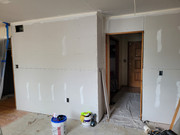The first rule I said when we were planning our remodel: “I want dimmers on every light.”
That turned out to be awkward in my basement remodel.
Nice! I really like that fixture.
Seems a little excessive. ![]()
I put dimmers on our dining room and living room lights when we first moved into this house. I put a dimmer in the basement when I finished that off into a TV room too. But that’s it. 3 dimmers total.
I’ve been a “dimmers everywhere” guy for decades. Some places are exceptions. Like an office you don’t want the outlets powering your equipment to be on a dimmer. So have dimming lamps instead.
By and large, any/all permanently installed lighting is on dimmers.
Yeah. It’s especially nice for the under cabinet lights in the kitchen, and a lot of indirect lighting we have in the living room. I haven’t counted, but I imagine we have at least 25 lights on dimmers.
It looks like you’re aiming for a Craftsman design style. It’s very good looking.
I mis-read the title as “Full Kitchen Rodeo” and had quit a laugh.
At least it’s not “Full Bedroom Redo/Rodeo”. That would be good for a double-take or two.
Ron White has a good skit on that topic that I wasn’t able to quickly find.
I’m a fan of dimmers, too. I keep adding them.
So another week wasted. ![]()
This is not a company that will be getting my recommendation.
But hey, at least all the inspections are done so work can finally get going.
Sorry to hear that. I don’t understand what makes it so difficult for contractors to properly estimate how long a project will take. We were over a year over past their scheduled completion date (not counting increases in scope of the project, which made it even longer)
Best wishes on smooth sailing from here. I have guys in the basement today installing a gas fireplace. This is the third time they’ve been scheduled to do it, but this time it’s actually happening.
There are sometimes legitimate reasons for delays. Everyone these days is facing worker shortages or worker no-shows for jobs. Materials can get delayed. Sometimes stuff just happens. Maybe a critical worker gets injured, for example.
That said, contractors will gladly over-book just to make sure that they don’t end up with idle time between jobs. It’s fairly common for them to come in and do at least some work so that it’s more difficult for you to cancel the contract. Once they have you on the hook, you’re kinda at their mercy. If they need to delay for any reason there often isn’t a whole lot you can do about it.
One way to combat this is to put significant penalties in the contract for late completion. Also, don’t make the final payments until the work is completed to your satisfaction.
We certainly experienced that.
I actually considered this when we were starting the project. The architect said something like “you could do that, but you really don’t want them rushing to finish on time rather than doing it right.”
This we did. We also negotiated a discounted P&O figure for the final months of the project.
Crew is here and sheetrock is going up. The floor should go in later in the week. I’ll finally have some real progress to report again!
Yesterday was the 2nd spackling job and the floor, grout is on Monday.


So when you enter the house, the tiles will start in a small foyer and go right into the kitchen.
We’re keeping the dining room wood though.
A good tile setter is an artist indeed.
Be sure to look for awkwardly positioned “repeats.” Most ceramic tile has 6 or 8 patterns that are repeated. Any good installer will check to make sure they are not laying 2 obvious repeats right next to each other.
1 of the tiles in the “stone-look” tile we chose for our front entry has n appearance that is pretty different than the other 5, with a noticeable blob of color. More distinctive that the wavy bottom rightmost tile in your second photo. You guessed it - the idiot installed 2 of those tiles right next to each other in the identical orientation, right in the middle of the entry way, such that they basically demanded your attention as you walked in the door. We made them replace one. They were not happy.
Looks like the OP has a handle on things. Daily inspections are important, but don’t let the euphoria of the job being “finished” make you drop your guard. On job-completion eve, go through the project again with an eye to detail. Put a piece of masking tape on every scratch, ding, paint slop or anything else that isn’t perfect, and make a written list: in other words, make a punch list for the contractor to complete. Once that’s done, you can both agree the work is finished. Most companies have a 30 day warranty period, so make sure everything is working on day 29. Most states have an implied one-year latent defect period, wherein if something fails because of, say, a wire coming loose from an outlet, or some other failure that you could not have possibly identified by a casual inspection, the contractor is on the hook for it.
I bookmarked this post, excellent suggestions.


